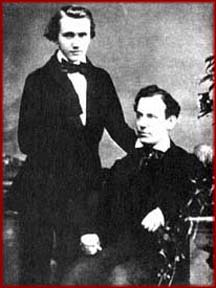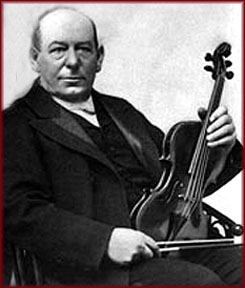




Johannes Brahms and Edouard Remenyi (1853)
Edouard Remenyi was one of the 19th century's most famous violin virtuosos, "a master of masters" who was so technically proficient that he was pronounced "the Liszt of the fiddle"[1] Liszt himself proclaimed Remenyi to be "the sole surviving possessor of the esoteric spirit of gipsy [sic] music … his heart is with the Hungarian melodies, which he plays with deep feeling."[2] Remenyi also was a composer of Hungarian dance music.[3] He introduced the young Johannes Brahms to the music of the gypsies and is credited with having inspired the composer's dynamic work "Hungarian Dances."[4]
The violinist was born Eduard Hoffman (he Hungarianized his surname to Remenyi) in Miskolc on January 17, 1828. According to one report, he was the son of John and Rosalie Hoffman;[5] but in those days, his parents' names more likely were Yohanan and Rosa. Although both his father and mother were Jewish, for purposes of professional advancement and to please his non-Jewish wife, Remenyi was not a practicing Jew. However, in his own way he was respectful of his heritage. While socializing after a concert in Philadelphia, Remenyi told a woman, "I am a born Roman Catholic, an Abbe," but then he winked and added, "a Kosher Abbe."[6] On another occasion, he went to a synagogue on erev Yom Kippur and during the chanting of Kol Nidre, he began to cry. "No man can run away from his blood or his true creed," he said. "The cruel suffering of the Jews is piteously told in their music and I am carried back to my mother's knees when I hear it."[7]
Remenyi studied music in Eger and Vienna. While still a teen-ager, he enlisted as a soldier and served as aide-de-camp to Hungarian commander-in-chief Gorgey during the 1848-49 uprising against Austria. He was present at most of the important battles, but was not allowed to be a combatant because, as camp violinist, he was said to be of such strategic importance to the morale of the troops that his life could not be risked. So critical was his role that the monarchy issued an edict forbidding him to play. "Special efforts" were made to capture him and he was forced to flee Hungary.[8] His pride in his military service was evident. A few years later, a music critic who met him while he was on tour in America described him as being "dressed in regimentals, scarlet coat, white vest, and gray pantaloons; on his breast was a large medaillon [sic] with the likeness of his illustrious countryman Kossuth."[9]
Remenyi was exiled from Austro-Hungary because of his part in the revolution, so he continued his career in the United States. He made a concert tour in Germany in 1853, with an unknown pianist named Johannes Brahms as his accompanist. Through his association with Remenyi, Brahms became familiar with the "alla zingaresestyle and csardas dances, elements of Hungarian folk music" that later were to inspire his compositions.[10]
Remenyi was appointed solo violinist to Queen Victoria in 1854. He spent several years touring the US until he was allowed to return to Hungary and received an appointment in the court of the Austrian emperor. In 1872, he married Gisella de Faj, daughter of the famous Hungarian musician Anton Faj. On the occasion of their wedding, Liszt composed a march and began writing a concerto for Remenyi. The couple had twin children named Adrienne and Tibor.[11]
Remenyi made numerous tours of Europe and a world tour in 1877, during which he was awarded many distinctions in recognition of his virtuouso performances.[12] In 1878, he took up permanent residence in the US. He died on-stage in 1898, while giving a concert in San Francisco.

Edouard Remenyi (ca. 1895)
Credits: Non-quoted text and page design copyrighted © 2008 by Helene Kenvin. Page created by Helene Kenvin. All rights reserved.